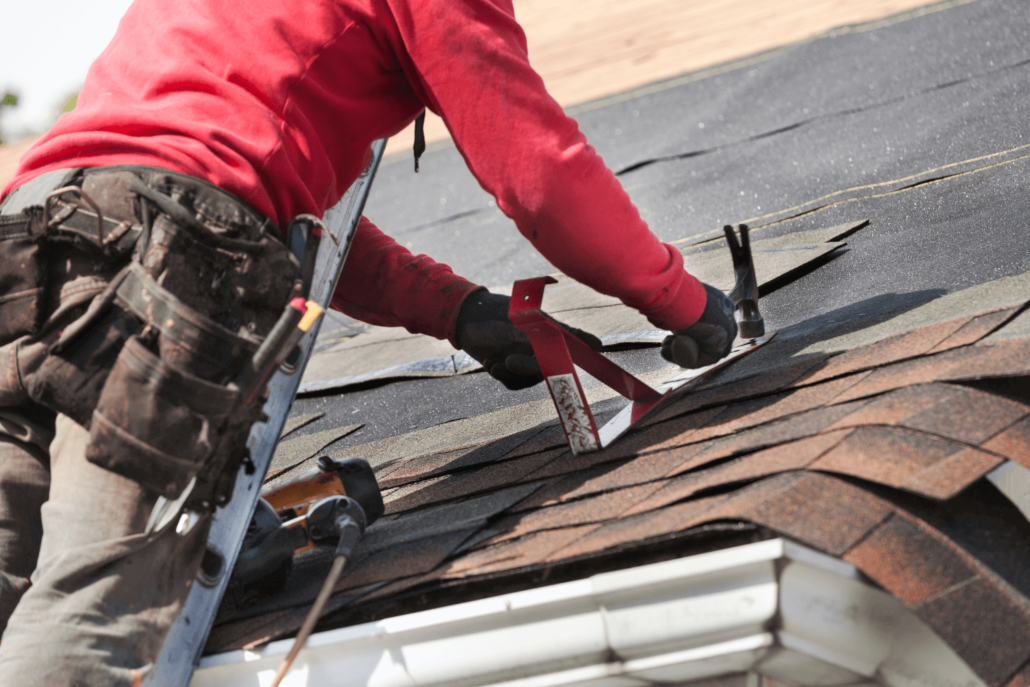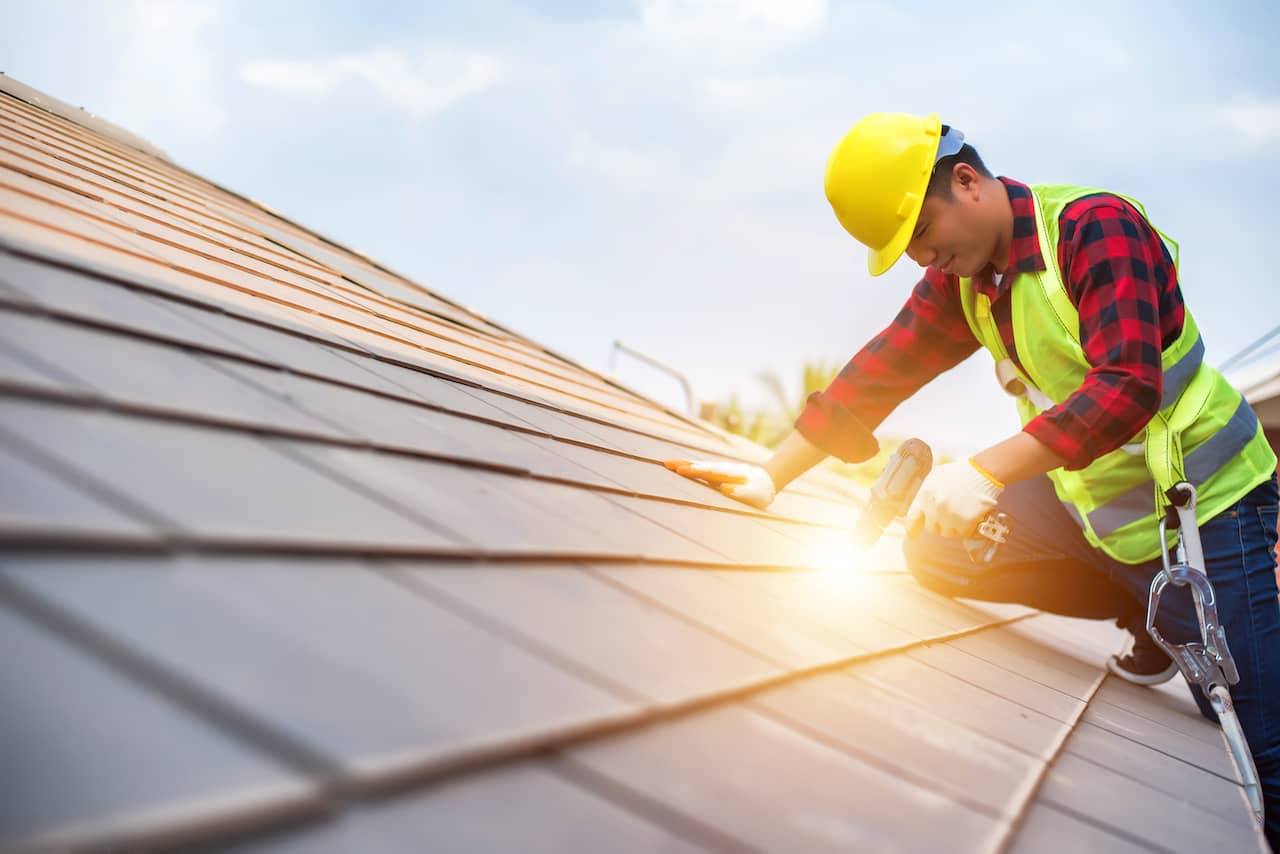Do It Yourself Roof Covering Repair Service: A Step-by-Step Overview to Repairing Common Issues
You can deal with typical roof covering issues yourself by starting with a detailed inspection for visible damage like missing out on shingles or sagging locations. Spot leakages by sealing replacing and flashing damaged tiles. Routine checks help stop expensive repairs.
 roof repair
roof repairExamining Your Roofing System for Damage
Prior to you climb up onto your roof, it's vital to inspect it from the ground to determine any noticeable signs of damages. Try to find missing out on shingles, curled edges, or discoloration that might show leakages. Watch out for sagging areas, which can signal architectural concerns. Take note of any kind of particles, like branches or leaves, that might be capturing dampness.
Next, check your seamless gutters for granules from tiles or standing water, both of which can indicate roof covering troubles. If you spot any spots on ceilings or wall surfaces inside your home, these can be signs of water damages connected to your roof covering.
Do not fail to remember to take a look at blinking around chimneys and vents, as damaged blinking can cause leakages. If you discover anything worrying, it's ideal to resolve it promptly to prevent much more extensive fixings later on. Always prioritize safety and security, and don't hesitate to call a professional if needed.
Collecting the Required Tools and Materials
Before you start your roof covering repair service, you need to collect the right tools and materials. Understanding what necessary tools you'll need, creating a list of needed materials, and focusing on security gear will certainly establish you up for success. Allow's review what you'll need to tackle this job successfully and safely.
 roof repair
roof repairEssential Devices Introduction
A solid roof fixing begins with the right devices and materials at your side. To tackle usual problems successfully, you'll require a few vital tools. First, grab a strong ladder to securely access your roof covering. A roofing hammer or a nail weapon will aid you protect tiles or various other products. Don't forget an energy blade for reducing roof materials properly.
Security equipment is crucial also; a pair of job handwear covers and safety goggles will certainly safeguard you from sharp sides and particles. A tape procedure warranties specific dimensions while a pry bar assists eliminate damaged tiles. With these tools in hand, you'll prepare to handle different roofing system repairs confidently.
Required Materials Checklist
With your devices ready, it's time to gather the materials required for your roofing system repair. Check your shingles. If they're harmed, buy matching substitute shingles. You'll likewise need roofing nails, a solid adhesive, and a sealer to guarantee every little thing remains leak-proof. Don't neglect a tarp or roof paper to safeguard exposed locations while you function. Take into consideration acquiring a water-proof membrane as well if you're dealing with leaks. For flashing repair work, buy brand-new blinking materials that fit your roof type. Get hold of a pail or container for any kind of debris you'll get rid of. Having all these products handy will make your repair service procedure smoother and more efficient, so you can obtain the task done right.
Security Gear Value
While you may be passionate to begin your roofing repair, don't overlook the relevance of security equipment. Wearing the ideal equipment can avoid serious injuries and ensure you function successfully. Start with a sturdy headgear to secure your head from falling debris. Non-slip shoes are crucial for maintaining grip on the roof's surface area. Do not fail to remember handwear covers; they'll maintain your hands risk-free from sharp tools and materials. Safety and security safety glasses will certainly secure your eyes from dust and debris. A harness is a should if your roof is high or high, preventing falls. A first-aid kit should always be on hand for small injuries. Prioritizing safety equipment sets you up for a successful and secure repair task.
Covering Roofing Leakages
When you discover a leak, the very first step is recognizing its source to ensure an effective spot. When you identify the issue, you'll require to choose the right products for a long lasting fix. We'll stroll you with the finest application techniques to secure those leakages and secure your home.
Determining Leak Sources
How do you pinpoint the resource of a roofing leakage? Beginning by checking your roof for noticeable damages or wear. Look for cracked shingles, missing out on tiles, or rusted flashing. Check the locations around smokeshafts, skylights, and vents, as these are typical leak areas. If it's risk-free, climb up to your roof and aesthetically check for any kind of irregularities. After hefty rainfall, go within your attic or top floorings to try to find water spots or drips. Utilize a flashlight to assist you see much better in dark locations. If you can't discover the source, take into consideration utilizing a yard tube to simulate rain, section by area, till you recognize where the water goes into. This technique can aid limit the leak's beginning.
Picking Spot Materials
Picking the appropriate spot materials is essential for successfully repairing a roofing leakage. For level roofings, make use of a specialized patching product designed for that surface.
Constantly ensure the materials are compatible with your existing roofing system to ensure a long-lasting repair. Additionally, inspect the climate condition; some materials require completely dry or cozy temperatures to stick appropriately. Lastly, choose premium items to avoid frequent fixings down info here the line. By choosing the ideal products, you'll establish on your own up for an effective patching job.
Application Strategies Explained
Using spot materials efficiently is essential for sealing roofing system leaks and stopping further damages. Start by cleaning up the area around the leakage, eliminating any particles, dirt, or loose roof shingles. This guarantees a strong bond in between the spot and the roof surface. Next off, reduce your patch material to fit over the harmed location, expanding it at the very least two inches past the sides of the leakage. Apply a generous layer of roof adhesive or sealer to the area, after that press the spot strongly into place. Ravel any air bubbles and verify the edges are well sealed. Finally, apply an additional layer of sealant over the spot borders for additional security. Enable the patch to treat totally prior to exposing it to rainfall or severe weather.
Replacing Broken Tiles
When you discover harmed tiles on your roofing, it's vital to deal with the concern quickly to prevent more leaks and architectural damage. Begin by collecting your tools: a lever, hammer, roof covering nails, and substitute shingles that match your existing ones. Very carefully raise the damaged shingle with your pry bar to remove it without disrupting the bordering roof shingles. Evaluate the location underneath for any type of indications of damage once it's complimentary. If whatever looks great, glide the new shingle right into area, straightening it with the others. Protect it with nails, making certain to follow the manufacturer's standards for positioning. Bear in mind to cover the nail heads with a bit of roof cement to ensure appropriate securing. Lastly, tip back and inspect your job to verify a seamless look. With these quick actions, you can efficiently change damaged shingles and preserve your roofing's integrity.
Cleansing and Preserving Gutters
To keep your roof in leading condition, regularly cleansing and preserving your rain gutters is essential. Blocked gutters can bring about water damages, mold development, and also architectural problems. Start by examining your rain gutters for particles like fallen leaves, twigs, and dirt. Use a tough ladder and wear handwear covers to eliminate any kind of buildup. An inside story or trowel can help you clear persistent clogs.
Following, flush your rain gutters with a garden tube to guarantee water streams easily. Look for leakages or rust areas while you go to it. Take into consideration using a sealant or replacing afflicted sections. if you discover any type of concerns.
To stop future clogs, install gutter guards or displays, and make it a routine to clean your gutters at the very least two times a year, especially before hefty rains or snow. Normal maintenance not only prolongs the life of your seamless gutters but likewise protects your whole roof.
Sealing Roof Vents and Flashing
Sealing roof vents and blinking is necessary for preventing leaks and protecting your home from water damage. Begin by examining the areas around your roof vents and blinking for any splits or spaces.
Apply the sealer kindly, loading all voids and splits, then smooth it out with your finger or a caulking device for a cool coating. Make certain the sealer prolongs slightly beyond the sides to develop a solid bond.
Allow the sealant to treat as per the supplier's directions, normally a few hours or overnight. After securing, it's a good idea to check your job after a rainstorm to verify every little thing keeps watertight. Regular maintenance of your roof covering vents and flashing can save you from pricey repair services down the line.
Checking and Fixing Roof Valleys
Roofing system valleys are vital areas where 2 inclines meet, and they play a crucial function in directing water away from your home. To examine your roofing valleys, start by climbing up safely and looking for indications of damages like loosened roof shingles, cracks, or debris.
For minor repair services, change damaged tiles and apply roof concrete to secure gaps. You could require to remove the afflicted area and set up brand-new flashing if the valley is extensively harmed. Make sure to overlap the brand-new materials appropriately to ensure a limited seal. After finishing your fixings, check the valleys throughout hefty rainfall to validate they're operating appropriately. Looking after roofing valleys quickly will help secure your home from water damage and expand the life of your roofing.
Frequently Asked Concerns
If My Roof Demands Replacement Rather of Fixing?, how Can I Identify.
To figure out if your roof requires replacement, check for extensive damages, drooping areas, or missing out on shingles. If leakages linger despite repairs or it's nearing completion of its life expectancy, take into consideration substitute over repair.
What Safety and security Precautions Should I Take While Fixing My Roofing System?
When repairing your roof covering, always put on a safety belt and non-slip footwear. See to it your ladder's steady, prevent working in negative climate, and have a person nearby to help you in instance of emergencies.
How Commonly Should I Evaluate My Roofing for Damage?
You should check your roof covering at the very least twice a year, ideally in spring and loss. After severe weather condition, check for damage also. Normal assessments can help you capture issues before they become costly fixings.
Can I Fix My Roofing in Bad Weather Condition Conditions?
You should not try roofing system repairs in poor weather. Rain, snow, or strong winds can boost threats and complicate the procedure. Wait on clear conditions to ensure your security and accomplish an appropriate repair work.
If I Come across Wild Animals in My Attic During Services?, what Should I Do.
If you encounter wild animals in your attic during repairs, quit quickly. Safeguard the area, prevent stunning the animals, and get in touch with an expert wild animals elimination solution to securely manage the scenario before proceeding your job.
Before you start your roof covering repair service, you require to gather the right tools and materials.A strong roof repair begins with the right devices and materials at your side.With your devices prepared, it's time to collect the products required for your roof covering repair work.Selecting the best spot products is vital for efficiently fixing a roof covering leak. Taking treatment of roof covering valleys quickly will help safeguard your home from water damage and extend the life of your roofing.